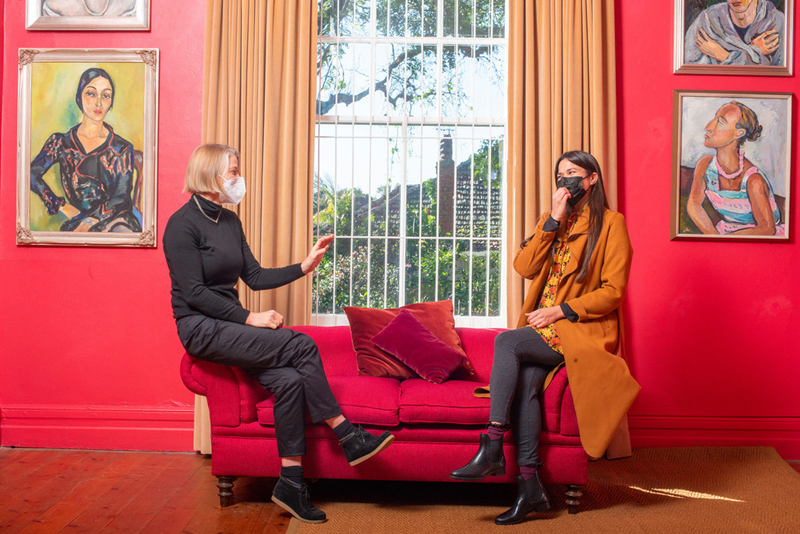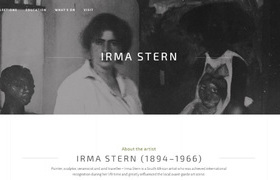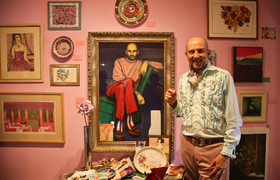In conversation with Irma Stern Museum’s new curator
06 October 2021 | Story Nadja Daehnke. Photo Supplied. Read time >10 min.
Curator and educator Yentl Kohler recently joined the University of Cape Town (UCT) Irma Stern Museum staff. Director, Nadja Daehnke, had a conversation about the ambitions Kohler brings to her new post.
Nadia Daehnke (ND): You have now been at the UCT Irma Stern Museum as curator and educator for a couple of weeks. What I just loved is how you came with such enthusiasm, but also such practicality. I saw how you are brimming with ideas and inspiration, but you also have these ideas firmly grounded in real life and with a passion for making sure that the ideas are practically and efficiently realised.
Yentle Kohler (YK): I think it comes from how I was raised and grew up. In our family we were always allowed to dream. Life wasn’t always easy, but we were always encouraged to work towards realising our dreams. And that is why in my studies, in my work and experiences I feel that I can do unconventional things that might not look like what anyone else is doing, but that are my version of my best.
ND: You can dream anything but that is different to making it happen – if you just dream it …
YK: I am fortunately also practical, so I focus on how to get things done: how we are going to make it happen, who will be involved … I use the word ‘recipe’ a lot for someone who doesn’t cook. It’s like you need this recipe to make this work.
ND: You are fine art trained, with a Fine Art degree from the UCT Michaelis School of Fine Art, and then chose to work in education. How did that happen – what was the journey that took you there?
“I feel that as an educator every day is a day to learn something new and to learn from the people I meet.”
YK: When I graduated from Michaelis with a degree in Sculpture, I loved making work, but I did not necessarily want to be a practising artist. When I looked back on my study period, I found the conversations, inter-personal sharing and crits in art school were what I found most enriching. I thought to myself, “What can I do to continue that feeling of enrichment?” So I continued with a Postgraduate Certificate in Education. And then I taught visual art in schools for a short period before I started at Iziko Museums as museum educator. My experience of teaching art in schools is actually a lot less than my experience as a museum educator.
I feel that as an educator every day is a day to learn something new and to learn from the people I meet. The teacher in me wants to be a lifelong learner and wants every day to be different and full of new things.
ND: And you have that passion to keep communicating that excitement for learning and for the new to others.
YK: I am passionate about this. For me, to be able to be in a position to welcome new people into the spaces that they might never have been before, and to be the first person that they see when they enter a museum space – I feel that is such a privilege to open up this moment to someone. No matter who comes through the door, they might remember the lady standing on the sidewalk saying: ‘Welcome Inside’.
ND: You speak about that moment of entering a museum space – what is the significance and possibility of that moment for you?
YK: To be honest, I came from a family that did not visit museums or know about the arts, and I am the only one in the family who does something in the visual art area. And it makes me a bit sad that the first time my parents and siblings entered a gallery space is when I graduated from Michaelis. And there are so many more families like this than there are not. So for me, that moment when children and adult visitors enter a museum, it is important that we do what we can to make them feel comfortable and welcome into spaces that many of them were not previously allowed in. Because that is just the truth of this country – that many people weren’t necessarily allowed in these spaces. There is a lot of unlearning that has to happen to make these visitors feel and believe that these spaces are there for them, and that these museum spaces aren’t there to make them feel like they do not understand or do not count. This moment of entering and acceptance is different for every single person, but I feel that is why we need to do what we do.
“As I walk through the rooms of this museum, I wonder what happened in them – who was there, what were the conversations that they had.”
ND: I remember once listening to a podcast in which Rachael Minott, the inclusion and change manager at the National Archives in the United Kingdom, was talking about an invisible sign above museum doors that still says “Not for you”. For much of South African history there was an actual physical sign above the door of cultural institutions, but even now so often an invisible version of that sign still hangs there.
YK: Yes, that sign is too often still there. That message is also differently emphasised in every single building and every single space. What people see and experience already from the outside is what welcomes them in, or makes them feel unwelcome – the architecture, signage, staff approach, and so many other things that signify belonging or rejection to different people. What the building was before to what is now, the visual and audio experience and interactions with other visitors and staff all evoke memories, and at times painful memories. Often it is hard and difficult to move past these memories and emotions and to enter or revisit the space and the memories in a new way.
ND: In relation to the UCT Irma Stern Museum, there is this long history of this site – from precolonial, to farm history, the Parker family that lived here, and then Irma Stern living here. And, of course, this museum is not purpose built, but a previously lived-in house. I know that the domesticity of the space is something you picked up in a previous conversation we had, where you said that when you enter the UCT Irma Stern Museum you feel like you are visiting someone’s house and that this shapes how you relate to it.
YK: I feel like I am visiting someone’s home, but they are not here. But this approach is also important and complex in terms of what home means to people, because home is a very difficult word in itself. A home could be a place, or a feeling, and for some home is intimately connected to family. And that in turn raises the question of what family means. As I walk through the rooms of this museum, I wonder what happened in them – who was there, what were the conversations that they had.
ND: This raises something I am very passionate about. I keep talking about the hidden characters of this site. So yes, there is Irma, and she is this larger-than-life character, but then less known are her live-in companions and her mother and father that stayed here for a while, and then the people who visited Stern in her house. We know about these people mainly through diary entries and letters in the archives. Then there are the more hidden characters like Charlie the cook and Asa the washerwoman and other people that are obliquely referred to with just one or two cryptic mentions in the historical record. Then there are people that have left no specific record of their lives: the pre-colonial users and occupants, and early colonial farmers that also lived on this site. I wonder what this site looked like before the garden-landscaping eradicated their presence? For me part of the UCT Irma Stern Museum is the immense diversity of stories that are here.
YK: It would be interesting to somehow create not a family tree, but a house tree, to try capture the voices of people whose families and communities were connected to this site.
ND: There is one thing I would like to push you a bit further on. When I asked what that moment of coming to the museum means to you, you spoke about inclusion and exclusion. I want to flesh that out a bit more: Why museums? Why not something else? What are you seeing as the possibilities that museums give to their visitors?
“The collections in this museum are an important part of South Africa’s and Africa’s cultural heritage.”
YK: I feel like that the one thing I would want visitors to see or feel when they come in here is that this is somebody’s story; this is somebody’s journey and someone’s collected memories of their travels and their life. The collections in this museum are an important part of South Africa’s and Africa’s cultural heritage, and I feel that these collections are an important record of a moment in not only in Irma Stern’s life, but all the places she travelled, and the people that she met.
And it would be amazing if people leave with the idea that they too can start documenting their life, because all of our lives are unique. For me it is always important for people to understand that we are all reporters of our time. I am especially passionate to get youth to turn the camera around and start looking, documenting, drawing and, through this, questioning and thinking.
ND: Expanding on this – I always like the moment when you have someone say “I can’t draw, I can’t paint, I don’t know colours, I am not good at art” – and then they put pen to paper and for once they leave their inhibitions and pre-conceived ideas behind and just play and explore. Speak to me about that and your experience in education around this.
YK: For me it always feels so strange when learners or adults in workshops say “I cannot draw”. After all, drawing is just mark-making; it doesn’t necessarily have to depict reality. But we are scared of making our mark because we are told that there is a right and a wrong way of making a mark. And then we are told that making your own mark on the world is not for the likes of you – that your voice, your mark, is not relevant or important. We become self-conscious, and we start comparing, start feeling like it’s not our right to make our mark. Within the museum I try, in a nurturing and caring way, to make it clear that everybody’s life is unique and how we perceive the world is unique, so our hand cannot do the same thing as the next person, but all those marks and voices matter.
ND: Talk a little bit more about your vision for the UCT Irma Stern Museum.
“I keep thinking about how I just want loads of people to experience this space.”
YK: I am so excited for the opportunity to be here and be part of this moment where the museum is busy expanding its ambit, and there are so many possibilities. The conversations around all those changes are for me incredibly exciting. I keep thinking about how I just want loads of people to experience this space. I want the imaginary sign we spoke about earlier to be removed. If it is there, I want that sign to be replaced with a feeling of welcome that should pervade this entire building, so that everyone can feel welcome.
I want to create programmes where people see this as not only Irma Stern’s former home, but as their home. I want this to be a museum where we can use art as a medium to teach, but also to heal, to bring together and to allow people to discover talent that they did not realise they had.
The UCT Irma Stern Museum is part of the University of Cape Town, it has strong links with the Western Cape Education Department and with various schools, it offers an inclusive education programme for youth with barriers to learning, and it is also loved and supported by Irma Stern scholars and a wider community of enthusiasts. I am very excited to meet the many people who have over many years visited and formed a bond with this site, to learn from them and make them feel even more part of this museum.
ND: And I am sure that our many current and future supporters will enjoy your energy, talent and passion for what you do. Thank you for becoming part of “Team Irma” and I look forward to working with you to make this museum an inclusive, much loved and much visited space.
 This work is licensed under a Creative Commons Attribution-NoDerivatives 4.0 International License.
This work is licensed under a Creative Commons Attribution-NoDerivatives 4.0 International License.
Please view the republishing articles page for more information.










